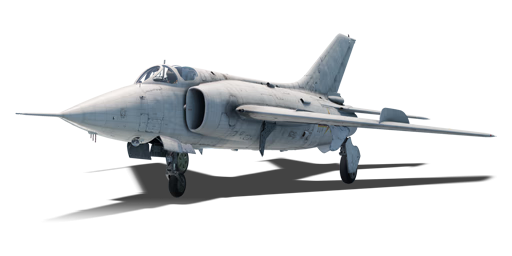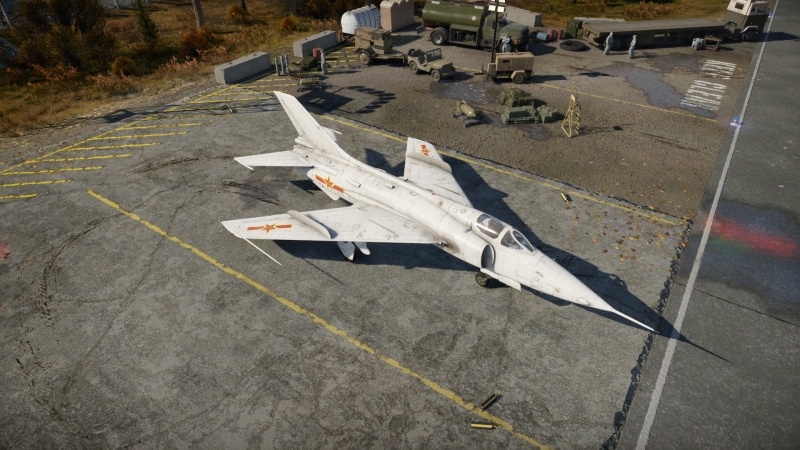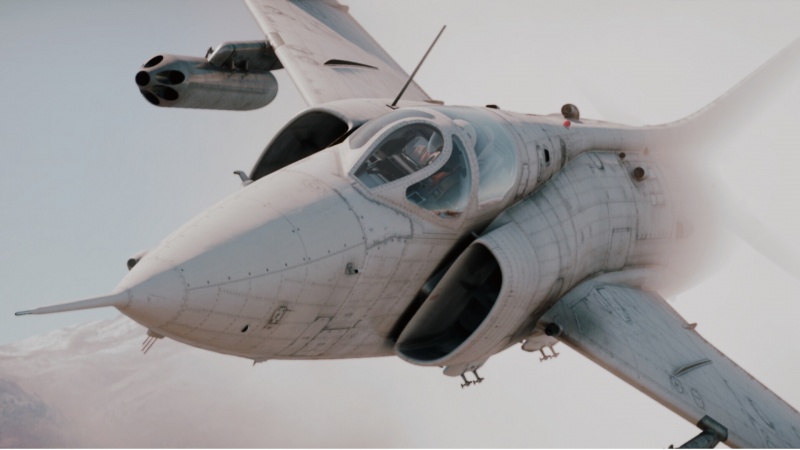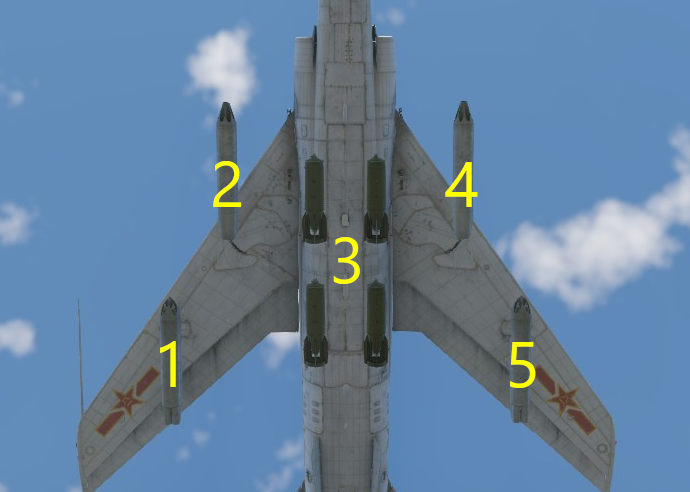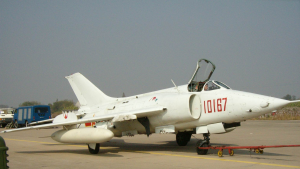Difference between revisions of "Q-5A"
CLOSE_RANGE (talk | contribs) (Updated armament and usage in battles.) |
Colok76286 (talk | contribs) (Edits) |
||
| Line 150: | Line 150: | ||
** 2 x 23 mm Type 23-2K cannons + 18 x countermeasures | ** 2 x 23 mm Type 23-2K cannons + 18 x countermeasures | ||
| − | As on the Q-5 early, the Q-5A is equipped with rapid- | + | As on the Q-5 early, the Q-5A is equipped with rapid-firing 23 mm cannons. While they are not particularly powerful on an shot-by-shot basis, the high rate of fire ensures that a brief burst of successful hits should be enough to put down most opponents. |
The Q-5A's ballistic computer grants CCIP for the cannons, which makes them slightly more practical for use against lightly armoured ground targets such as SPAAs and IFVs. | The Q-5A's ballistic computer grants CCIP for the cannons, which makes them slightly more practical for use against lightly armoured ground targets such as SPAAs and IFVs. | ||
| Line 205: | Line 205: | ||
Like the Q-5 early, the Q-5A is a light ground attacker whose rockets are limited in capacity and whose bombs are limited in power. The Q-5A has a ballistic computer for all ordnance onboard, so players can finally precisely target enemies with guns, bombs, and rockets. It's generally best to use up the rockets and bombs in several passes, then switch to providing air cover. If there are no enemy aircraft or helicopters around, the Q-5A can quickly zoom back to the airfield and restock its weapons for another run. | Like the Q-5 early, the Q-5A is a light ground attacker whose rockets are limited in capacity and whose bombs are limited in power. The Q-5A has a ballistic computer for all ordnance onboard, so players can finally precisely target enemies with guns, bombs, and rockets. It's generally best to use up the rockets and bombs in several passes, then switch to providing air cover. If there are no enemy aircraft or helicopters around, the Q-5A can quickly zoom back to the airfield and restock its weapons for another run. | ||
| − | The Q-5A can carry 90 mm and 130 mm rockets simultaneously. The 130 mm rockets are generally the more effective of the two types because they can easily destroy light targets, even with near-misses, and have the potential to destroy even MBTs with a direct hit through overpressure. However they have a very limited capacity and unlucky hits may only do superficial damage to armoured targets due to their lack of a HEAT warhead. The ballistic computer makes it possible to use them as makeshift standoff weapons against light targets: a good salvo can knock them out from several | + | The Q-5A can carry 90 mm and 130 mm rockets simultaneously. The 130 mm rockets are generally the more effective of the two types because they can easily destroy light targets, even with near-misses, and have the potential to destroy even MBTs with a direct hit through overpressure. However they have a very limited capacity and unlucky hits may only do superficial damage to armoured targets due to their lack of a HEAT warhead. The ballistic computer makes it possible to use them as makeshift standoff weapons against light targets: a good salvo can knock them out from several kilometres away. The 90 mm rockets require direct hits to do any real damage, but also do not have enough capacity to be fired in huge swarms as might be done with the American [[FFAR Mighty Mouse]] rockets. They can be used as backups for when the 130 mm rockets are spent or in close range strafing runs as a stronger alternative to cannons. |
The 250 kg Type 250-2 bombs are the Q-5A's best bet against armoured targets, but they do not have much explosive content and need to be delivered with decent accuracy in order to score kills. In Q-5A's case, the addition of the belly fuel tank located in the previous bomb bay caused designers to move the pair of internal bomb racks onto the belly as well; which does help Q-5A for better accuracy with a tighter radius. The CCIP functionality greatly helps in placing them accurately but it does not guarantee pinpoint drops. As with traditional bombing, the most consistent results are obtained by approaching at steeper angles. | The 250 kg Type 250-2 bombs are the Q-5A's best bet against armoured targets, but they do not have much explosive content and need to be delivered with decent accuracy in order to score kills. In Q-5A's case, the addition of the belly fuel tank located in the previous bomb bay caused designers to move the pair of internal bomb racks onto the belly as well; which does help Q-5A for better accuracy with a tighter radius. The CCIP functionality greatly helps in placing them accurately but it does not guarantee pinpoint drops. As with traditional bombing, the most consistent results are obtained by approaching at steeper angles. | ||
Revision as of 11:00, 29 November 2022
| This page is about the Chinese strike aircraft Q-5A. For other versions, see Q-5 (Family). |
Contents
Description
The Q-5A is a rank VI Chinese strike aircraft with a battle rating of 10.0 (AB), 9.7 (RB), and 10.3 (SB). It was introduced in Update "New Power".
The Q-5A is externally very similar to the Q-5 early aside from the pure white paint scheme. This variant has several new features: it now has flares, a radar warning receiver, a ballistic computer, and a new pair of hardpoints for mounting 130 mm high-explosive rockets. The flight performance has also been improved noticeably, courtesy of the more powerful engines. The Q-5A is an all-round improvement with enhanced self-defense in air combat and much higher efficacy in ground attack.
General info
Flight performance
The Q-5A weighs negligibly more when empty than the Q-5 early, which is more than compensated by the fact that its engines produce about 15% more thrust. Its top speed is now practically the same as or in some cases slightly better than the J-6A under 10,000 metres. The internal bomb bay has been replaced with a fuel tank and the maximum fuel capacity is now 70% larger.
It still compresses more in dives and has somewhat worse low speed handling than the J-6A, but at reasonable fuel settings the Q-5A comes very close to the J-6A in terms of climb, acceleration, and energy retention. The control compression can be considered its primary weakness: watch the indicated airspeed carefully and remember to throttle back or use airbrakes as needed to ensure that the Q-5A remains controllable. The turn rate and manoeuvring energy retention are quite balanced at high subsonic speeds, which can be used to gain the upper hand in extended dogfights.
| Characteristics | Max Speed (km/h at 7,000 m) |
Max altitude (metres) |
Turn time (seconds) |
Rate of climb (metres/second) |
Take-off run (metres) | |||
|---|---|---|---|---|---|---|---|---|
| AB | RB | AB | RB | AB | RB | |||
| Stock | 1,434 | 1,430 | 16500 | 25.4 | 25.7 | 139.4 | 129.4 | 850 |
| Upgraded | 1,450 | 1,442 | 24.5 | 24.9 | 187.0 | 161.1 | ||
Details
| Features | |||||
|---|---|---|---|---|---|
| Combat flaps | Take-off flaps | Landing flaps | Air brakes | Arrestor gear | Drogue chute |
| X | ✓ | ✓ | ✓ | X | ✓ |
| Limits | ||||||
|---|---|---|---|---|---|---|
| Wings (km/h) | Gear (km/h) | Flaps (km/h) | Max Static G | |||
| Combat | Take-off | Landing | + | - | ||
| 1260 | 577 | N/A | 500 | 450 | ~9 | ~5 |
| Optimal velocities (km/h) | |||
|---|---|---|---|
| Ailerons | Rudder | Elevators | Radiator |
| < 540 | < 650 | < 350 | N/A |
Engine performance
| Engine | Aircraft mass | ||||||
|---|---|---|---|---|---|---|---|
| Engine name | Number | Basic mass | Wing loading (full fuel) | ||||
| Shenyang Liming WP-6A-III | 2 | 6,593 kg | 337 kg/m2 | ||||
| Engine characteristics | Mass with fuel (no weapons load) | Max Takeoff Weight | |||||
| Weight (each) | Type | 10m fuel | 20m fuel | 30m fuel | 34m fuel | ||
| 725 kg | Afterburning axial-flow turbojet | 7,424 kg | 8,256 kg | 9,087 kg | 9,420 kg | 12,500 kg | |
| Maximum engine thrust @ 0 m (RB / SB) | Thrust to weight ratio @ 0 m (WEP) | ||||||
| Condition | 100% | WEP | 10m fuel | 20m fuel | 30m fuel | 34m fuel | MTOW |
| Stationary | 2,650 kgf | 3,709 kgf | 1.00 | 0.90 | 0.82 | 0.79 | 0.59 |
| Optimal | 2,677 kgf (1,000 km/h) |
3,786 kgf (1,000 km/h) |
1.02 | 0.92 | 0.83 | 0.80 | 0.61 |
Survivability and armour
- 10 mm steel plate behind nose cone
- 4.5 + 8 mm bulletproof glass in front of the cockpit
- 8 mm steel plate underneath cockpit
- 16 mm steel armoured pilot's seat
- 10 + 25 mm steel armoured pilot's headrest
- Self-sealing fuel tanks behind cockpit and underneath engines in rear fuselage
The Q-5 protects the pilot from small arms fire, but this level of protection does not amount to much in the jet era. Enemy cannons and missiles will make short work of the Q-5 so avoiding incoming fire is paramount. The twin engines are likely to be damaged by attacks from the rear, but having two of them offers some extra survivability since it is capable of flying back to base on one engine. The elevators also have separate damage models and the aircraft remains somewhat controllable if one of them is blown off.
Modifications and economy
Armaments
| Ballistic Computer | |||
|---|---|---|---|
| CCIP (Guns) | CCIP (Rockets) | CCIP (Bombs) | CCRP (Bombs) |
| |
|
|
|
Offensive armament
The Q-5A is armed with:
- A choice between two presets:
- 2 x 23 mm Type 23-2K cannons, wing-mounted (120 rpg = 240 total)
- 2 x 23 mm Type 23-2K cannons + 18 x countermeasures
As on the Q-5 early, the Q-5A is equipped with rapid-firing 23 mm cannons. While they are not particularly powerful on an shot-by-shot basis, the high rate of fire ensures that a brief burst of successful hits should be enough to put down most opponents.
The Q-5A's ballistic computer grants CCIP for the cannons, which makes them slightly more practical for use against lightly armoured ground targets such as SPAAs and IFVs.
Suspended armament
The Q-5A can be outfitted with the following ordnance presets:
- Without load
- 4 x 250 kg Type 250-2 bombs (1,000 kg total)
- 14 x Type 90-1 rockets
- 8 x Type 130-2 rockets
Custom loadout options
| 1 | 2 | 3 | 4 | 5 | ||
|---|---|---|---|---|---|---|
| 250 kg Type 250-2 bombs | 4 | |||||
| Type 90-1 rockets | 7 | 7 | ||||
| Type 130-2 rockets | 4 | 4 |
The Q-5A has access to all of the loadouts of the Q-5 early, the difference being that it can equip two rocket pods with four 130 mm Type 130-2 rockets in addition to the 90 mm Type 90-1 rockets. The 130 mm rockets pack HE warheads with 7.68 kg of TNT equivalent each, roughly comparable to the US Zuni rocket. A direct hit to the turret and hull roof armour of a MBT can cause catastrophic or fatal damage. Side aspect shots can be questionable, especially against Soviet MBTs with thick side armour. Lightly armoured targets should be annihilated if hit anywhere. The capacity of 8 is very limited but the ballistic computer greatly helps in aiming them.
The Type 90-1 rockets are better than the anaemic S-5 rockets used by typical Soviet jets and can penetrate 280 mm of armour with 1.03 kg of TNT equivalent, but typically several hits are required to destroy an armoured target due to the lower post-penetration effect.
The four 250 kg bombs should be familiar to anyone who has used the Q-5 early, but the Q-5A does not have an internal bomb bay and all four are mounted on fuselage hardpoints instead. This causes more drag but the pilot no longer has to worry about manually opening the bomb bay. These are small for the Q-5's battle rating and four of them is not enough to destroy a single base. In mixed battles, they require more precision against ground targets than the typical 1,000 lb/500 kg bombs used for CAS. The Q-5A's ballistic computer offers CCIP, but not CCRP functionality for these bombs.
Usage in battles
Although it was historically an attack aircraft, the Q-5 is not a first-rate ground attacker in Air RB since its ordnance is rather anaemic compared to other jets at its battle rating. It cannot destroy a base with its four 250 kg bombs, but this is still an option for supplementary research points when grinding: stay at low altitude, loop around to a side base, drop the bombs, then head towards the center of the map to join the furball. Going after AI ground vehicles with the bombs and rockets can also be successful provided that other jets do not arrive quickly to crash the party.
The Q-5A can outrun many of the enemy fighters it faces, but active combat at transonic or supersonic speeds should be avoided because of the control compression. The best way to reverse enemies is to pull them into a climbing spiral or other vertical manoeuvres; the Q-5 has enough of the MiG-19's climb and thrust-to-weight characteristics to energy fight in a similar manner, the declining airspeed relaxes the control compression, and a stalled-out target is easier to gun down. It should be obvious that actual MiG-19 models such as the German MiG-19S are better than the Q-5A in almost every regard when it comes to air-to-air combat. Be very careful about engaging them.
Take advantage of the flares and RWR. Flares are intended to spoof infrared guided missiles. For best results, deploy them in bursts while cutting the afterburner and making evasive manoeuvres, which will hopefully cause the missile to chase a flare instead. Only 18 flares can be carried in total, which is really not much compared to the A-4E's 60 for example. Definitely use them against dangerous missiles that cannot be evaded easily such as the R-60 or AIM-9G, as they will buy time for reversing the target and can save the Q-5A during energy-draining vertical combat. Missiles with limited manoeuvrability or track rates can be dodged with good manoeuvring. The Q-5A can load chaff countermeasures in addition to flares, but chaff is less needed since only primitive radar-guided missiles are present in its BR range.
The RWR will not stop any missiles by itself, but knowing if there are pursuers or radar locks behind you reduces the chance of being surprised by a missile or cannon burst out of nowhere. The RWR is not a replacement for situational awareness, it is still the pilot's duty to look for approaching enemies and missile launches whenever possible.
Ground RB
Like the Q-5 early, the Q-5A is a light ground attacker whose rockets are limited in capacity and whose bombs are limited in power. The Q-5A has a ballistic computer for all ordnance onboard, so players can finally precisely target enemies with guns, bombs, and rockets. It's generally best to use up the rockets and bombs in several passes, then switch to providing air cover. If there are no enemy aircraft or helicopters around, the Q-5A can quickly zoom back to the airfield and restock its weapons for another run.
The Q-5A can carry 90 mm and 130 mm rockets simultaneously. The 130 mm rockets are generally the more effective of the two types because they can easily destroy light targets, even with near-misses, and have the potential to destroy even MBTs with a direct hit through overpressure. However they have a very limited capacity and unlucky hits may only do superficial damage to armoured targets due to their lack of a HEAT warhead. The ballistic computer makes it possible to use them as makeshift standoff weapons against light targets: a good salvo can knock them out from several kilometres away. The 90 mm rockets require direct hits to do any real damage, but also do not have enough capacity to be fired in huge swarms as might be done with the American FFAR Mighty Mouse rockets. They can be used as backups for when the 130 mm rockets are spent or in close range strafing runs as a stronger alternative to cannons.
The 250 kg Type 250-2 bombs are the Q-5A's best bet against armoured targets, but they do not have much explosive content and need to be delivered with decent accuracy in order to score kills. In Q-5A's case, the addition of the belly fuel tank located in the previous bomb bay caused designers to move the pair of internal bomb racks onto the belly as well; which does help Q-5A for better accuracy with a tighter radius. The CCIP functionality greatly helps in placing them accurately but it does not guarantee pinpoint drops. As with traditional bombing, the most consistent results are obtained by approaching at steeper angles.
Although the Q-5A has the tools to unleash a fair amount of pain on enemy tanks, its lack of long-range guided weapons like the AGM-12B Bullpup makes it vulnerable to radar-guided SPAA guns, or even IFVs with optical tracking. Use the RWR, keep a low profile, and pay attention to the battlefield to determine if it is safe to get close. If not, plan approaches carefully and use the rockets to clear out threats from safer distances. Once enemy defenses are suppressed, the bombs can be used at leisure.
Pros and cons
Pros:
- High acceleration, great energy retention, and decent climb rate
- Faster than the Q-5 early
- Good ammunition stock
- Good sustained manoeuvrability, can out-turn F-4 Phantoms and keep up with MiG-21s
- First aircraft in the Chinese tech tree to have flares
- Has a radar warning receiver
- 130 mm rockets pack quite a punch against ground targets when detonating on target
- Ballistic computer for gun, rockets, and bombs
Cons:
- Gun-fighter only, still no missiles
- Average roll rate
- Tail locks up at high speeds
- Easily beaten in manoeuvrability by subsonic aircraft
- The 23 mm cannons sometimes fall short in damage, less lethal than J-6A's 30 mm cannons
- Ordnance capacity is still below average for its rank
History
The Nanchang Q-5A 'Fantan' was the first variant of the Chinese ground attack aircraft, which has seen over 50 years of continuous service.[1] Developed in the early 1950s as a replacement for ageing Soviet-made IL-10 attack aircraft, the plane was developed from the MiG-19 airframe. Though it entered service relatively late due to the effects of the Cultural Revolution, it still saw extensive service as the primary attack aircraft of the Chinese Air Force. As well, it was exported to several countries including Pakistan, Bangladesh, and Myanmar. Though it has now been retired from active Chinese service, the aircraft remains in service with the Myanmar Air Force.[1][2]
Design and development
In the early 1950s, China lacked and needed a new ground attack aircraft. While other nations were re-equipping with advanced attack aircraft such as the A-4 Skyhawk and F-100 Super Sabre, the Chinese Air Force still used the obsolete propeller-powered IL-10, a relic of the Second World War. As a result, the Chinese Air Force started studying concepts for a new supersonic jet-powered attack aircraft. As the state of Chinese aircraft technology was far behind from other nations, and as a result, existing designs were studied; these included the Soviet Su-7 and MiG-19, which was already in service as the Shenyang J-6.[2] As a result, the final design was based on the MiG-19, and shared many of its characteristics.[2]
The Q-5 shared the MiG-19's aft section and engines, but had a completely redesigned forward section making it 25% longer.[2] As a result, the aircraft had a significantly reduced top speed, though it was still capable of flying supersonic. The nose was redesigned and featured the air intakes on the sides, behind the cockpit, while the cockpit canopy was adjusted as well. The armament was changed to two 23 mm cannons in place of the MiG-19's NR-30s.[2]
The Q-5's construction was delayed due to the effects of the Great Leap Forward and the Cultural Revolution. Thus, the first Q-5 prototype flew on June 4th, 1965.[2]
Operational history
The first Q-5As entered in the early 1970s in limited quantities, followed by mass-scale production. Over the course of a decade, almost 600 Q-5A airframes were built. As well, a small number of Q-5As were modified to carry a single nuclear bomb semi-recessed in the fuselage; one of the modified aircraft was indeed used in this manner in a nuclear bomb test in January of 1972.[3] The Q-5As used in this role are easily identifiable because of the bright-white anti-flash paint scheme that protected the aircraft from nuclear flash.[2][3]
The Q-5A saw little combat action due to its relatively short time in service before being superseded by later variants of the aircraft. However, modified Q-5As remained the backbone of China's tactical nuclear strike force for several years. Though it has since been superseded in the nuclear and conventional strike role by the JH-7 Flying Leopard, late variants of the Q-5 remain in service with the Myanmar Air Force.[1][2]
Media
- Skins
- Videos
See also
Links to the articles on the War Thunder Wiki that you think will be useful for the reader, for example:
- reference to the series of the aircraft;
- links to approximate analogues of other nations and research trees.
External links
References
- Citations
- Bibliography
- Peck, M. (2019, October 18). Meet the Nanchang Q-5: China's Nuclear Bomber. Retrieved November 20, 2020, from https://nationalinterest.org/blog/buzz/meet-nanchang-q-5-chinas-nuclear-bomber-89681
- Eastern Order of Battle. (n.d.). Nanchang Q-5 Fantan attack aircraft at the People's Liberation Army Air Force Part One. Retrieved November 20, 2020, from http://www.easternorbat.com/html/nanchang_q-5_fantan_01_eng.html
- Staff Writer. (2020, April 27). Nanchang Q-5 (Fantan) Ground Attack / Close-Air Support (CAS) Aircraft. Retrieved November 20, 2020, from https://www.militaryfactory.com/aircraft/detail.asp?aircraft_id=568
| Nanchang Aircraft Manufacturing Corporation 南昌飞机制造公司 | |
|---|---|
| Strike aircraft | Q-5 early · Q-5A · Q-5L |
| A-5C | |
| China jet aircraft | |
|---|---|
| Fighters | J-2 · J-4 · J-6A · J-7II · J-7D · J-7E · J-8B · J-8F · J-10A · J-11 · J-11A |
| Strike aircraft | Q-5 early · Q-5A · Q-5L · JH-7A |
| Bombers | H-5 |
| France | ␗Mirage 2000-5Ei |
| USA | ␗F-84G-21-RE · ␗F-84G-31-RE · ␗F-86F-30 · ␗F-86F-40 · ␗F-100A · ␗F-100F · ␗F-104A · ␗F-104G · ␗F-5A · ␗F-5E · ␗F-16A MLU |
| USSR | ␗MiG-9 · ␗MiG-9 (l) |
| North Korea | Shenyang F-5 |
| Pakistan | A-5C · JF-17 |


